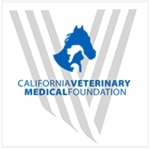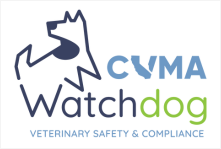This article was originally printed in the January/February 2025 issue of the California Veterinarian magazine.
The California Environmental Protection Agency (Cal EPA) is one of several government agencies that has legal authority over the veterinary profession.
Cal EPA is responsible for protecting, enhancing, and restoring the environment and protecting human health. Among its many branches, the Department of Toxic Substances Control (DTSC) oversees hazardous waste regulations.
Because veterinary practices generate hazardous waste, the law requires practices to conform to standards regarding hazardous waste storage and disposal, and to register with Cal EPA as hazardous waste producers, report to the agency annually, and post a warning to the public regarding certain chemicals present in the practice.

What Is Hazardous Waste?
Hazardous waste is a waste with properties that make it potentially dangerous or harmful to human health or the environment.
Hazardous wastes can be liquids, solids, or contained gases. In classifying hazardous waste, the DTSC applies four criteria: whether the material is ignitable, toxic, corrosive, or reactive.
Examples of hazardous waste in a veterinary practice include anesthetic gases, batteries, certain chemotherapeutics, copper, selenium or zinc boluses for livestock, epinephrine, ether, ethylene oxide, fluorescent light bulbs, formalin, lead, mercury, old “tube” televisions or computer monitors, radiographs or radiographic fix containing rare earth metals (e.g.: silver), reserpine, and strong acids or bases.
It is important to note that from a legal standpoint, such items do not become “waste” until they are discarded.
Registering with Cal EPA
California regulations require veterinary practices, as generators of hazardous waste, to register with the DTSC by obtaining a Hazardous Waste Identification Number. DTSC Form 1358 is used to apply for the free identification number. More information about registering and access to the online form can be found by clicking here.
Annual ID Number Verification Questionnaire
Cal EPA registrants are required to verify their information with the DTSC annually per Health and Safety Code section 25205.16(b) to ensure that the information linked to the ID number is current. The questionnaire is only available online through the Electronic Verification Questionnaire (eVQ) system. To create a profile in the eVQ system, visit https://evq.dtsc.ca.gov/evq/Register.aspx.
Note that even if a veterinary practice does not produce any hazardous waste in a given year, it still must annually verify contact information and confirm the types of hazardous materials present in the practice.
Disposing of Hazardous Waste
Hazardous waste generated in veterinary practices must be transported and disposed of through registered EPA approved Hazardous Waste Transporters. A list of Cal EPA approved hazardous waste haulers can be found at the QR code. A manifest of disposed waste will be provided by the hazardous waste hauler. Practices are required to send DTSC a copy of the waste manifest within 30 days of shipping the waste.
The mailing address is:
DTSC Generator Manifests
P. O. Box 400
Sacramento, CA 95812-0400
Veterinary practices are required to retain copies of hazardous waste manifests for three years pursuant to California Code of Regulations (CCR), Title 22, Section 66262.40.
Cal EPA Inspections
The DTSC may inspect veterinary practices for potential violations to hazardous substance laws. The inspection authority is granted to the DTSC under CCR Title 22, Section 66272.10. Inspections can range from simple “fix-it” orders to monetary fines to—in extreme cases—criminal prosecution and/or immediate business closure.
It is recommended that if your business is cited by the DTSC you immediately obtain legal counsel to represent you.
Consumer Products Exposure Warning
The Cal EPA Office on Environmental Health and Hazard Assessment (OEHHA) requires that a warning be provided in any business where chemicals are present that are known to cause cancer, birth defects, or other reproductive harm.
Veterinary practices commonly utilize chemicals that would meet these criteria and therefore must provide the Consumer Products Exposure Warning (also termed the “Proposition 65 Warning”).
The notice can either be provided through product labeling or through signage posted in a prominent location in the business. The legal requirements for the notice can be found in CCR Title 27, Section 25603.1.
For more information about Cal EPA requirements, visit cvma-watchdog.net to access resources in the Regulatory Compliance Section, or visit the Cal EPA regulatory assistance website at https://dtsc.ca.gov/rao/
This article is for informational and general educational purposes only. It is not intended to take the place of legal advice, nor should it be considered as a legal interpretation. Although significant effort has been made to ensure the accuracy and completeness of the information at the time of publication, the CVMA shall not be responsible for any errors or omissions, or any agency’s interpretation, application, or enforcement of the information presented herein.









